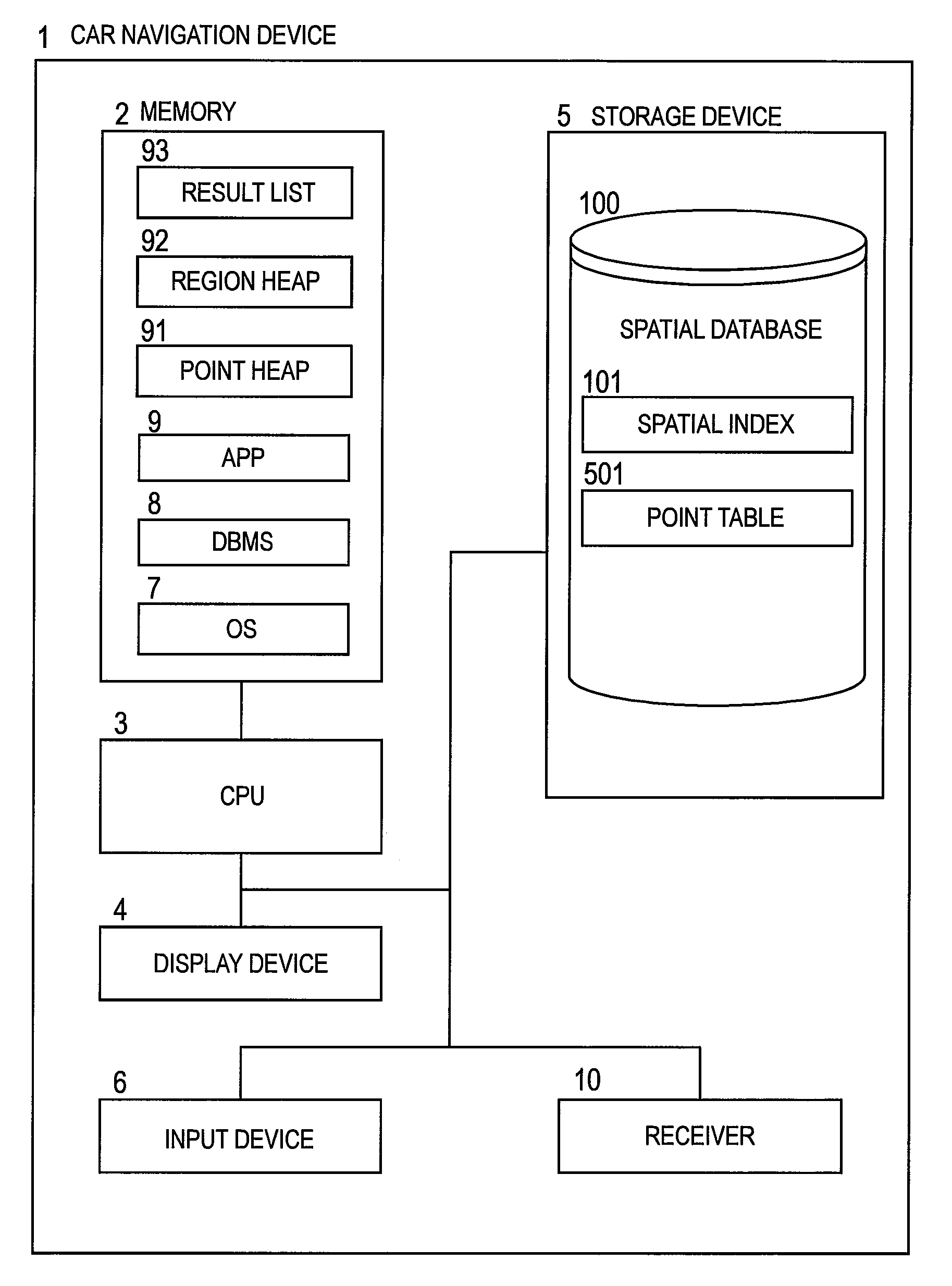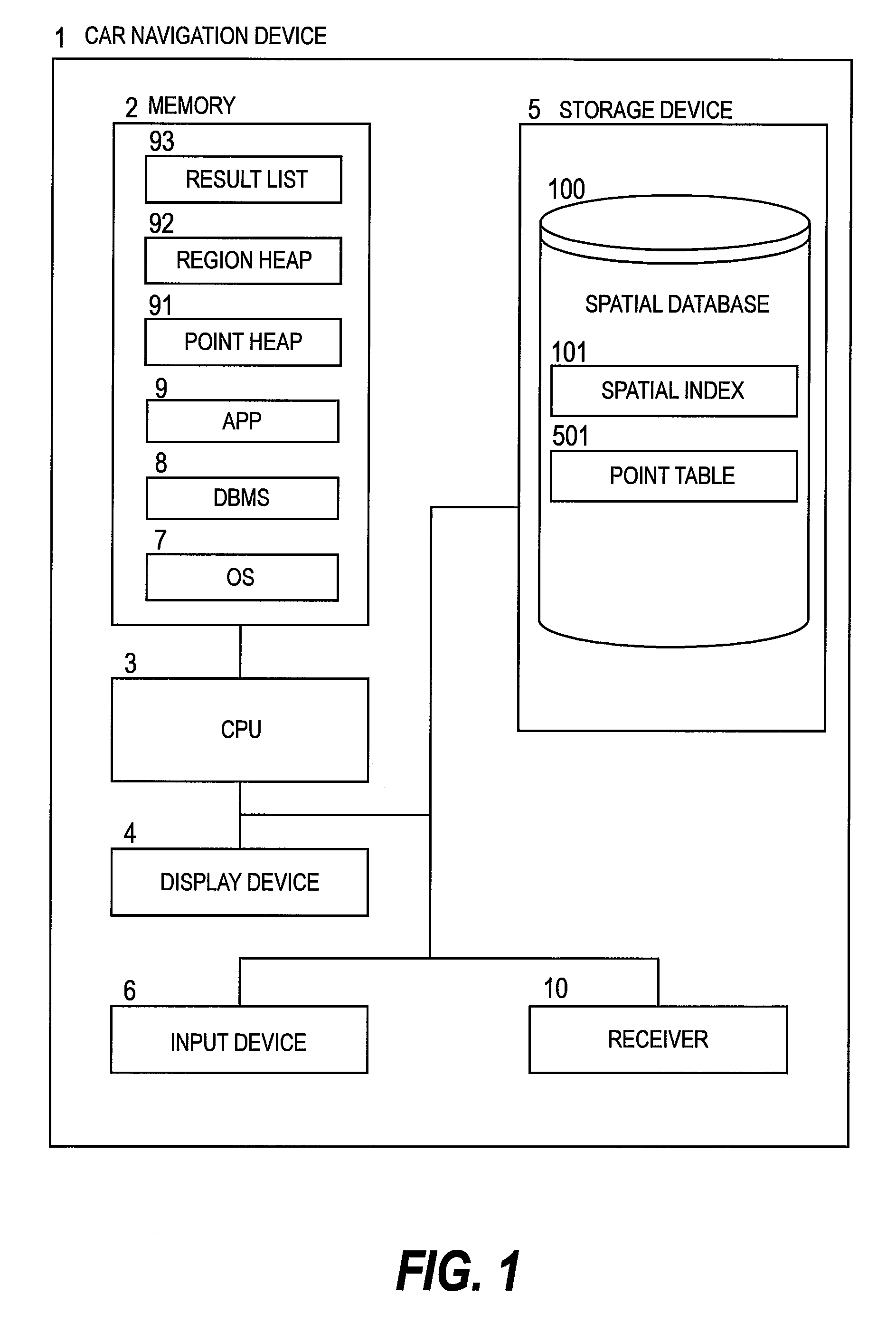K-nearest neighbor search method, k-nearest neighbor search program, and k-nearest neighbor search device
a technology of neighbor search and search method, applied in the field of neighbor search technique, can solve the problems of extension of search time, wide search range, application of conventional technique to embedded devices, etc., and achieve the effect of reducing the number of points targeted, and reducing the number of disk accesses
- Summary
- Abstract
- Description
- Claims
- Application Information
AI Technical Summary
Benefits of technology
Problems solved by technology
Method used
Image
Examples
first embodiment
[0059]FIG. 1 is a block diagram illustrating an example of a car navigation device according to a first embodiment of this invention. A car navigation device 1 includes a CPU (Central Processing Unit) 3 for executing calculation processing, a memory 2 for temporarily storing data or programs, a storage device 5 for storing data or programs, an display device 4 for outputting a calculation result, an input device 6 for receiving an entry from a user, and a receiver 10 for receiving a signal from a GPS (Global Positioning System) satellite.
[0060]The storage device 5 stores a spatial database 100 which includes graphic elements such as points, lines or surfaces of map objects, and attribute elements such as characters or numerical values indicating contents of the objects. Among information stored in the spatial database 100, information of one spot such as a shop or facility is a point.
[0061]In the memory 2, a DBMS (Database Management System) 8 for managing the spatial database 100, ...
second embodiment
[0125]The second embodiment is an extension of the first embodiment and is designed to realize k-nearest neighbor search considering attribute search for solving the above-mentioned third problem.
[0126]Specifically, the point table 501 of FIG. 5 of the first embodiment is extended to employ a point table 2101 illustrated in FIG. 21. FIG. 21 illustrates an example of a point table for information on a leaf node of a quadtree. The point table 2101 includes, in addition to a point ID 511, coordinates 512 of X and Y coordinates, and a pointer 513, a point type 514 in point information of the table for storing points. For example, in the case of a point table of a car navigation device 1, the point type may store types of a point such as a restaurant, a parking lot, a gas station, and so on. With the addition of the point type 514 to the point information, in the information on the leaf node of the quadtree, a point type 514 is added to point information of each point.
[0127]Processing of...
third embodiment
[0132]The third embodiment is an extension of the first embodiment and is designed to provide nearest neighbor search for solving the above-mentioned fourth problem. Processing of the third embodiment basically conforms to the flowchart of FIG. 6 of the first embodiment. Specifically, an interruption condition is set in search conditions so that search processing can be interrupted even during searching processing. For example, an interruption condition is described by a distance from a query point. In this case, search processing is interrupted at time when no point present within a range of the distance is found. As an interruption condition, setting of maximum processing time is effective. In this case, time which can be expended for the search processing is set to maximum processing time and, at time when an elapsed time of the search processing becomes equal to the maximum processing time, the search processing is interrupted. A case where a distance is used as an interruption ...
PUM
 Login to View More
Login to View More Abstract
Description
Claims
Application Information
 Login to View More
Login to View More - R&D
- Intellectual Property
- Life Sciences
- Materials
- Tech Scout
- Unparalleled Data Quality
- Higher Quality Content
- 60% Fewer Hallucinations
Browse by: Latest US Patents, China's latest patents, Technical Efficacy Thesaurus, Application Domain, Technology Topic, Popular Technical Reports.
© 2025 PatSnap. All rights reserved.Legal|Privacy policy|Modern Slavery Act Transparency Statement|Sitemap|About US| Contact US: help@patsnap.com



